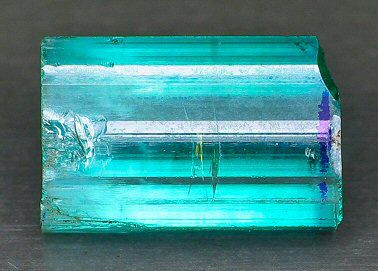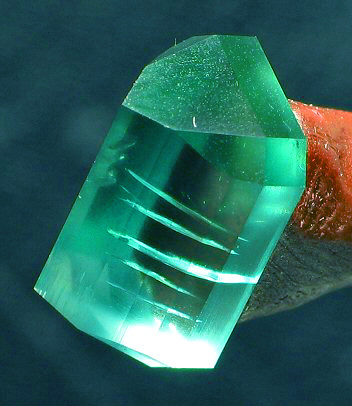Not only is it difficult to find fine quality facet rough gemstone material, but one never knows about issues that cannot be seen during the initial inspection process. Once purchased, there can be surprises when one polishes a window to look inside. That isn't the end of it though! During the faceting process, the gem can have cleavage issues depending on the type of gemstone. Cracks can develop due to internal stress and they can develop where no cracks were visible previously. A gemstone could be near completion and the lap can be contaminated, leaving scratches on the surface and many facets would then have to be refaceted. Unforeseen problems can occur during the fashioning process and this can result in the entire loss of the gemstone - and that can mean hundreds to thousands of dollars as in the case described below.
Wonderfully Colored Neon Blue Nuristan Tourmaline (below) - Purchased in the 1980s by All That Glitters directly from an Afghani and stored in the bank all this time. The Tourmaline crystal ends were sawn off, removing the natural termination of the crystal as well as the opposite end. One can see some cracks in about the center of the stone that reach the surface and also go down into the piece of rough. A chip on the left hand side must also be removed. A large facet which will become the table now must be cut, and this will remove both issues, without hopefully not having to go too deep. The deeper one goes, the less the weight of the final gemstone.

This picture shows the same issues but the cracks can be more clearly seen from this angle. Note the distinct color difference - from this angle from the side/end, the color is more green, but from the top, it is a neon blue. This is a physical property of some gemstones called Dichroism - in this case, the two different axes have different colors. In this tourmaline, the two colors are complimentary. If the side color was too dark or an olive green, the final gemstone would not be as attractive, and All That Glitters would have passed on the rough. This is about as fine it gets with the two colors - the other option, which is very rare, the two axes would have the same color.

The photo below shows that the pavillion(bottom) of the gemstone was essentially completed, and because the gemstone was under stress (not uncommon), cracks developed spontaneously on either side of the gemstone. This was totally unforeseen, but does happen. This can happen not only with Tourmaline, but any gemstone has the potential to have issues during the cutting. The loss to All That Glitters is very high for this piece and in its current condition, is best used as colorful gravel in a fish tank.

Many dealers, cutters, miners and the like prefer to facet gemstone rough versus selling it, but as you can see, what looks like an incredible piece which may command a high price when faceted, can actually end up as a large loss. It is a gamble - sometimes we win, but many times we loose...